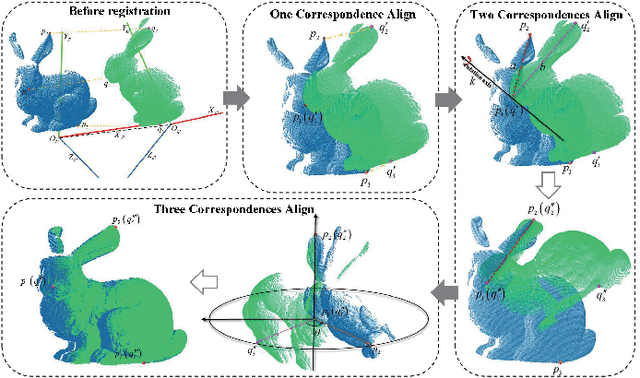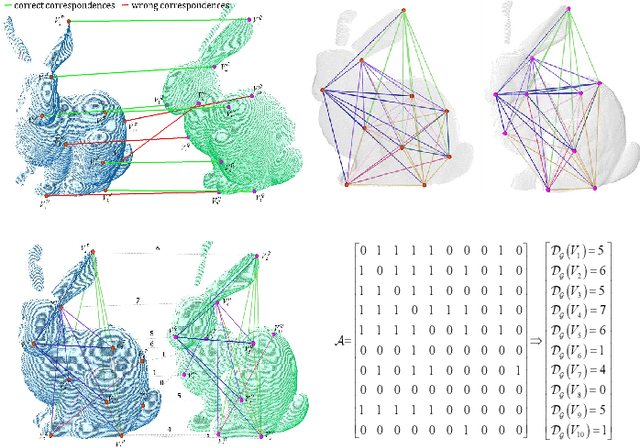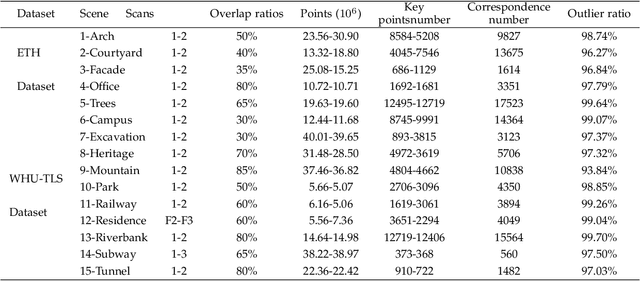Pengcheng Wei
Micro-Structures Graph-Based Point Cloud Registration for Balancing Efficiency and Accuracy
Oct 29, 2024Abstract:Point Cloud Registration (PCR) is a fundamental and significant issue in photogrammetry and remote sensing, aiming to seek the optimal rigid transformation between sets of points. Achieving efficient and precise PCR poses a considerable challenge. We propose a novel micro-structures graph-based global point cloud registration method. The overall method is comprised of two stages. 1) Coarse registration (CR): We develop a graph incorporating micro-structures, employing an efficient graph-based hierarchical strategy to remove outliers for obtaining the maximal consensus set. We propose a robust GNC-Welsch estimator for optimization derived from a robust estimator to the outlier process in the Lie algebra space, achieving fast and robust alignment. 2) Fine registration (FR): To refine local alignment further, we use the octree approach to adaptive search plane features in the micro-structures. By minimizing the distance from the point-to-plane, we can obtain a more precise local alignment, and the process will also be addressed effectively by being treated as a planar adjustment algorithm combined with Anderson accelerated optimization (PA-AA). After extensive experiments on real data, our proposed method performs well on the 3DMatch and ETH datasets compared to the most advanced methods, achieving higher accuracy metrics and reducing the time cost by at least one-third.
Autonomous Exploration Method for Fast Unknown Environment Mapping by Using UAV Equipped with Limited FOV Sensor
Feb 05, 2023Abstract:Autonomous exploration is one of the important parts to achieve the fast autonomous mapping and target search. However, most of the existing methods are facing low-efficiency problems caused by low-quality trajectory or back-and-forth maneuvers. To improve the exploration efficiency in unknown environments, a fast autonomous exploration planner (FAEP) is proposed in this paper. Different from existing methods, we firstly design a novel frontiers exploration sequence generation method to obtain a more reasonable exploration path, which considers not only the flight-level but frontier-level factors in the asymmetric traveling salesman problem (ATSP). Then, according to the exploration sequence and the distribution of frontiers, an adaptive yaw planning method is proposed to cover more frontiers by yaw change during an exploration journey. In addition, to increase the speed and fluency of flight, a dynamic replanning strategy is also adopted. We present sufficient comparison and evaluation experiments in simulation environments. Experimental results show the proposed exploration planner has better performance in terms of flight time and flight distance compared to typical and state-of-the-art methods. Moreover, the effectiveness of the proposed method is further evaluated in real-world environments.
A New Outlier Removal Strategy Based on Reliability of Correspondence Graph for Fast Point Cloud Registration
May 16, 2022



Abstract:Registration is a basic yet crucial task in point cloud processing. In correspondence-based point cloud registration, matching correspondences by point feature techniques may lead to an extremely high outlier ratio. Current methods still suffer from low efficiency, accuracy, and recall rate. We use a simple and intuitive method to describe the 6-DOF (degree of freedom) curtailment process in point cloud registration and propose an outlier removal strategy based on the reliability of the correspondence graph. The method constructs the corresponding graph according to the given correspondences and designs the concept of the reliability degree of the graph node for optimal candidate selection and the reliability degree of the graph edge to obtain the global maximum consensus set. The presented method could achieve fast and accurate outliers removal along with gradual aligning parameters estimation. Extensive experiments on simulations and challenging real-world datasets demonstrate that the proposed method can still perform effective point cloud registration even the correspondence outlier ratio is over 99%, and the efficiency is better than the state-of-the-art. Code is available at https://github.com/WPC-WHU/GROR.
 Add to Chrome
Add to Chrome Add to Firefox
Add to Firefox Add to Edge
Add to Edge